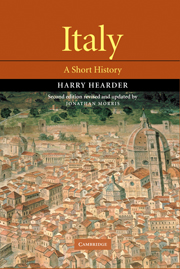Book contents
- Frontmatter
- Contents
- List of illustrations
- Preface
- 1 Italy in the classical world
- 2 The early Middle Ages
- 3 The high Middle Ages
- 4 The Renaissance
- 5 The political and cultural eclipse of Italy
- 6 The Risorgimento, 1790–1861
- 7 From Unification to Fascism, 1861–1922
- 8 The Fascist disaster, 1922–45
- 9 Italy since the Second World War, 1945–80
- Epilogue: From the First to the Second Republic: Italy 1980–2001
- A brief guide to further reading
- Index
7 - From Unification to Fascism, 1861–1922
Published online by Cambridge University Press: 05 February 2015
- Frontmatter
- Contents
- List of illustrations
- Preface
- 1 Italy in the classical world
- 2 The early Middle Ages
- 3 The high Middle Ages
- 4 The Renaissance
- 5 The political and cultural eclipse of Italy
- 6 The Risorgimento, 1790–1861
- 7 From Unification to Fascism, 1861–1922
- 8 The Fascist disaster, 1922–45
- 9 Italy since the Second World War, 1945–80
- Epilogue: From the First to the Second Republic: Italy 1980–2001
- A brief guide to further reading
- Index
Summary
The first years of unity and the era of Depretis and Crispi, 1861–96
By 1861 the epic phase of the Risorgimento was over. The Kingdom of Italy had been created, and although one major war of independence was still to be fought, the main task now was to integrate and standardize institutions, so that the new kingdom could become a genuine nation state. Benedetto Croce argued that this task was more difficult than the more dramatic ones which had preceded it. The institutional unification was not made any easier by the fact that there was no man of vision to carry it through. Cavour was dead. Mazzini refused to recognize the conservative monarchy as the Italy for the creation of which he had devoted his life. Garibaldi thought only of securing Rome, and although – unlike Mazzini – he accepted election to the Italian parliament, he was out of sympathy with the new regime.
The men who had to carry through the institutional unification were the party of the Right, the successors of Cavour. The state they created combined parliamentary institutions of a British kind with administrative institutions of a French kind. Administration was to be strongly centralized, with the country divided into prefectures and sub-prefectures, with prefects and sub-prefects appointed in Turin. It was the system Napoleon I had made common throughout much of Western Europe, and it has survived in Italy, as in France, until this day, although with significant modifications.
- Type
- Chapter
- Information
- ItalyA Short History, pp. 198 - 224Publisher: Cambridge University PressPrint publication year: 2001

